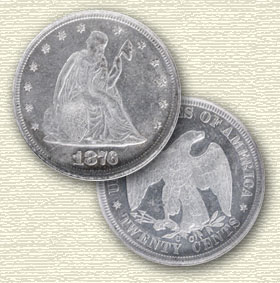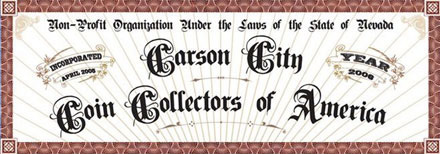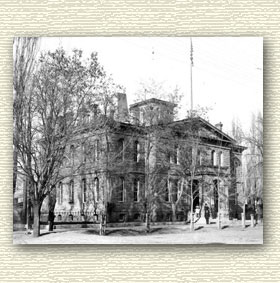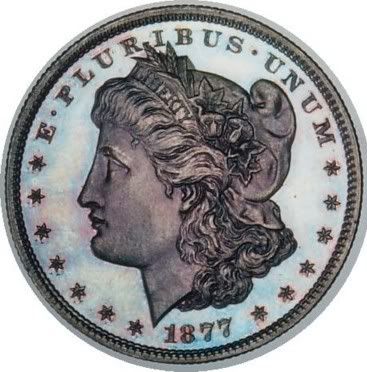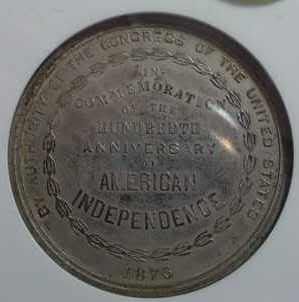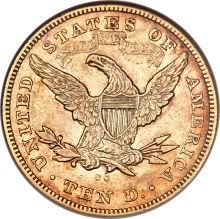- Posts: 91
- Thank you received: 0
1876-CC $10 Gold Coin of the Week 04/03/2011
- deepsouthspike
-
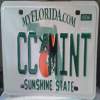 Topic Author
Topic Author
- Offline
- Senior Member
-

July 4th 1976 marked the 200th Anniversary of the adoption of the Declaration of Independence, The United States Bicentennial. To celebrate Americas 200th Birthday, an International fleet of almost 150 Warships, classic Tall sailing ships and more than 28,000 Sailors from over 50 Countries gathered along the New York Harbor and the waterway surrounding the Statue of Liberty in what organizers called, “Operation Sail”, the largest Maritime event of its kind in history. It was one of the most memorable days of my life!
As a boy just learning the value of a hard earned dollar, I landed myself a delivery job for a local market when this momentous and rewarding day arrived; I earned almost $300 in wages and tips on that day. Quite a sum of money for a boy my age at the time! Best of all, I was still able to enjoy the climax of the festivities that same evening as the Macys fireworks lit up the entire New York skyline while patriotic music filled the air in a magnificent and amazing display of celebration. It made you feel so proud to be an American!
The Leap year of 1876 saw a Nation full of newsworthy and twisted events taking place such as the Great “Whiskey Scandal”, and even an attempt was made to steal the body of Abraham Lincoln. The National League of Professional Base Ball Clubs was formed in Chicago in 1876, the (NL) is considered by many to be the first “major league”. In this same year Dan De Quille, the pseudonym that William Wright used on the Territorial Enterprise published in Virginia City Nevada, first published “The Big Bonanza”. Per a publisher’s summary, it was a basic source book on the history of Nevada’s fabulous Comstock Lode and listed it as the story of the discovery and development of the immensely rich Big Bonanza, written by the man best qualified to do the job. He was persuaded to write this book by his former colleague, Mark Twain , who also published his literary classic in 1876, “The Adventures of Tom Sawyer” which was not supposed to be a children’s book, Twain had written it to remind older people about what their world was like when they were young.
Another very noteworthy event taking place in 1876 was when George T. Morgan, assistant Engraver at the Philadelphia Mint , met Miss Anna Willess Williams, an “art student” through some friends. Morgan had just received the go ahead to design the new dollar coin and with some encouragement Miss Williams reluctantly agreed to pose as a model for Morgan. All she had asked was for her identity to remain a secret. Morgan met with Williams a total of five sessions in 1876, completing his design. But somehow just a short while after the release of the new dollars, a reporter revealed Williams as the “Silver Dollar Girl”. It has been argued that Morgan never used Williams’s likeness, instead creating the design strictly from his imagination. I am including an image of an 1877 capped Miss Liberty “half dollar” design; once it was approved, it was transferred to the new dollars of 1878 including those struck at the Carson City Mint.
In 1876, Pioneers could buy government land at very low prices by agreeing to go west and settle on the land, but many only pretended to be settlers and turned around and sold their land to land companies for profit. In Virginia City Nevada, The Bucket of Blood Saloon had just been rebuilt after the Great fire of 1875 which had consumed more than half the buildings in the town and on November 28th 1876, the excited residents of Virginia City also christened their new monument to education, the Fourth Ward School. Today this historical treasure is a museum featuring programs designed to tell the real story of the American West. Over in Carson City, the newly built Bullion and Exchange Bank located at the corner of Carson and Proctor had just opened its doors for business and Carson City’s Virginia and Truckee Railway Depot had daily inspections performed prior to any trains departing the station. Everything had to be clean as a whistle, with the engine and cars shining like mirrors and every bit of brass polished so that not even a speck of dust could be found. Could you imagine finding such a high standard of cleanliness on any mass transit system in America today?
At the U.S. Mint on 600 North Carson Street, operational costs were soaring beyond the planned budget allowances which lead to a pay cut of fifteen percent for non salaried workers. Per Mint Mark CC by Howard Hickson , James Crawford, who had taken over as the Superintendant of the Carson City Mint in September of 1874 was already on his way at the beginning of 1875 to San Francisco to confer with the Mint Director on plans for the enlargement of the Carson City Mint. The new plans were calling for an addition of over 13,000 square feet to be built to alleviate some of the cramped conditions. In 1876 Superintendent Crawford made his next attempt at seeking financial aid; he traveled to Washington where he persuaded Representative William Woodburn of Nevada to introduce an appropriation bill calling for $200,000 to enlarge the Carson building. The Bill was defeated.
Crawford arrived back in Carson City just in time to come under fire from charges made by the San Francisco Bulletin. In its edition dated March 20th 1876, the paper accused the Carson City Mint of allowing underweight trade dollars to be issued. The tabloid suggested the “CC” Mint should be closed. Then a local newspaper, The Morning Appeal , came to the Mints defense explaining the coins which assayed light had undergone extreme heat during a fire in Virginia City. The affair was dismissed yet a shadow of doubt remained. Finally, a bill allowing only approximately half of the original requested appropriations was passed; this is part of the reason leading up to the reduction in wages at the Mint. In James Crawford, Master of the Mint at Carson City – A Short Full Life by Rusty Goe , Rusty quotes, “even dogs eat crumbs that fall from their masters table”. Rusty wrote, though financial “crumbs” would indeed sustain operations at the Carson Mint for years to come, allocations for expansion and other tenant improvements would prevent it from reaching its full potential. The workers were the ones to suffer because the Officers salaries were set by law. Crawford quickly assured everyone under his Supervision that although the wages of non-salaried personnel would be trimmed, no jobs would be lost.
With all of this taking place at the time, another suitable quotation comes to mind, “A successful man is one who can lay a firm foundation with the bricks others have thrown at him”. Superintendant Crawford certainly was that man!
Per The Mint on Carson Street by Rusty Goe , to meet heavy export demand, The Nation’s Gold Coinage production increased sharply in 1876 but only meager amounts of $10 Eagles were delivered by the three coinage Mints, Philadelphia, Carson City and San Francisco. Gold coin production at the “CC” Mint was concentrated mainly on Double Eagles in this year.
The 1876-CC Coronet or “ Liberty Head” design type with In God we Trust above Eagle has the sixth lowest mintage of all of the “CC” Gold Eagles. The 1876-CC Eagle has an undisputed recorded total mintage of 4,696 coins but the survival estimates vary a great deal depending on which reference you are looking at. In researching this date, statistics indicate anywhere from 70 to 150 survive in all grades. Population reports from the two leading grading company’s numbers surpass this 150 total count; it is more than likely that this combined data also includes many resubmitted coins. Despite the large variance in survival estimates, the 1876-CC Eagle is still considered to be about the eighth rarest date overall in the series of “CC” Gold Eagles that lasted nineteen different years in total.
Christian Gobrecht is credited with the design along with James B Longacre being noted for the added motto in the scroll. Metal composition is comprised of .900 in Gold and .100 in Copper and the weight is listed as approximately 16.718 grams with a reeded edge and measuring about 27mm in diameter. In “Gold Coins of the Carson City Mint” by Douglas Winter/edited by James Halperin , it was noted that the quality of strike seen on Carson City Eagles improves over the poor level seen on the 1872 through 1875 issues. However, many examples seen do not have very good eye appeal.1876-CC Eagles are most often found with rim marks , heavy abrasions, softly struck at the centers, faint mint marks, poor luster and many have been cleaned or dipped. Attractive, original examples command much higher prices.
The 1876 Carson City Eagle has only a single variety known. The mintmark is small and widely spaced with the first “C” a bit higher than the second. The second “C” nearly touches the bottom of the arrow feather. Several “CC” Eagle dates are unknown in (MS) Mint State condition and the 76-CC is amongst them. The highest graded that I have been able to find any record of are a few AU55 and AU58 examples listed in the population reports at the major grading services. After reviewing about 25 major auction archive results from about a ten year time span, I was able to comprise the following data. 18 of the 25 most common auction grades ranged between EF45 to AU53, with AU53 being the highest and F12 being the lowest. The 25 auctions selected all appear to be fairly original coins with no problems noted on the PCGS and NGC holders.
Some major auction results with (varying grades and prices) realized for the 1876-CC Eagles over the past ten years were as follows
Fine ($1,437 to $3,220)
VF ($3,565 to $5,175)
EF ($7,475 to $8,650)
AU50 ($10,060 to $14,375)
AU53 ($13,225 to $19,550)
Current Coin Values as of March 2011 list the 76-CC Eagles as the following varying price ranges
F-12 $2,500, VF20 ($3,600 to $4,750), EF40 ($7,500 to $7,750), AU50 ($13,500 to $21,500), and AU58 at $40,000 (Eight years ago, a budget minded collector such as myself could have purchased a PCGS F-12 example for just $1,400, today, this same coin would probably cost me over $3,000)
One example of an 1876-CC Eagle that I have just seen recently listed for sale, an NGC graded AU50 example, was priced to sell at $15,000
Judging from the few remaining specimens available to us as collectors today, it’s easy to see how the gold coins from the Carson City Mint surely served many purposes over those magical Comstock years. And as collectible and cherished golden rounds of history to us, it appears their values should only trend upwards as the demand for them continues to grow. The 1876-CC Eagle mintage is just a minuscule percentage of the almost 300,000 total Ten dollar Carson City Gold Eagles produced over the course of the 19 different years. The Centennial year of 1876 certainly saw some fireworks at the Carson City Mint and it was definitely some interesting and wonderful times across this great Nation!
Posted in this Land of E PLURIBUS UNUM by Tom DeFina on Sunday April 3rd, 2011
Please Log in to join the conversation.
- Loosechange
- Offline
- Platinum Member
-

- Married to my best friend!
- Posts: 504
- Thank you received: 0
Loosechange
Go "CC'S"
Please Log in to join the conversation.
It always gives us an added treat to write about coins made in the Centennial Year, doesn't it? You did an outstanding job linking your recollections of the Bicentennial Year of 1976 with key historic facts about 1876. Your extra-credit inclusion of the George T. Morgan story about using Anna Williams as a model for his new coin design definitely added a nice touch to your article.
You wrote:
This is an important observation that will find mutual agreement among those of us who are constantly searching for 1876-CC gold eagles.1876-CC Eagles are most often found with rim marks , heavy abrasions, softly struck at the centers, faint mint marks, poor luster and many have been cleaned or dipped. Attractive, original examples command much higher prices.
Later you wrote:
Specimens in any of these grades that possess attactive appeal are worthy of consideration.I was able to comprise the following data. 18 of the 25 most common auction grades ranged between EF45 to AU53, with AU53 being the highest and F12 being the lowest.
Your statement that,
is a thought that helps put the rarity of this date (and most other dates in the "CC" gold eagle series) in proper perspective.The 1876-CC Eagle mintage is just a minuscule percentage of the almost 300,000 total Ten dollar Carson City Gold Eagles produced over the course of the 19 different years.
Kudos to you for another passionate and comprehensive COTW posting.
The enthusiam that all of you COWboys consistently display in your posts has helped keep the fire burning on this commendable project.
Rusty
C4OA Lifer!
Please Log in to join the conversation.
- deepsouthspike
-
 Topic Author
Topic Author
- Offline
- Senior Member
-

- Posts: 91
- Thank you received: 0
I am honored to have been asked to be a part of the "COWboys"! Thank you for your replies on my latest post on the 76-cc Eagle. Actually, when I began thinking of ideas for this article, at one point I had up to fourteen pages in notes. What you see posted here today is the shortened version condensed to about seven pages.
Loosechange, Whatever gave you the idea I am leaving the COWboys????? On the contrary Sir, I am already gathering information about my next post. Thank you again to everyone for all the encouragement you have provided to myself and to one another. The greatest part of this Forum in addition to all the knowledge that I have gained from each of you, is the enjoyment I have received from all of your wonderful and valued Friendships!
I look forward to next week's post already!
Best
Tom DeFina.....deepsouth
Please Log in to join the conversation.
- Loosechange
- Offline
- Platinum Member
-

- Married to my best friend!
- Posts: 504
- Thank you received: 0
Loosechange
Go "CC'S"
Please Log in to join the conversation.
Yet another Carson City coin article worthy of publishing in Curry's Chronicle or any periodical of Curry's quality with appreciative, numismatically savvy readers.
You've managed to get all of our patriotic juices flowing big time with your opening about the country's 200 year birthday celebration back in 1976. I clearly remember that very same image of the three mast sailing ship alongside the fire department's boat spouting fireworks of water. Even though I only saw the photo on the front page of our local newspaper, it's an image that would be tough to forget.
I own a very average, VF-30 NGC example of the 1876-CC Eagle. Rusty and I have been searching for a worthy AU replacement for this coin, but have yet to come across one. The few that have surfaced in auctions have all had problems.
Tom, do you own a copy of the Big Bonanza? I wonder if Rusty or any of our regular C4OA members has a copy in their personal library? It would be a fascinating read, posed as it is in 19th century morality and viewpoints. Did Wright work on the book from a base out west? Did he publish the book in affiliation with the Territorial Enterprise?
Your Coin of the Week article featuring the 1876-CC $10 was a not only fact-filled, it was a very fun article to read, too boot!
Belay Off
C4OA Lifer!
Please Log in to join the conversation.
